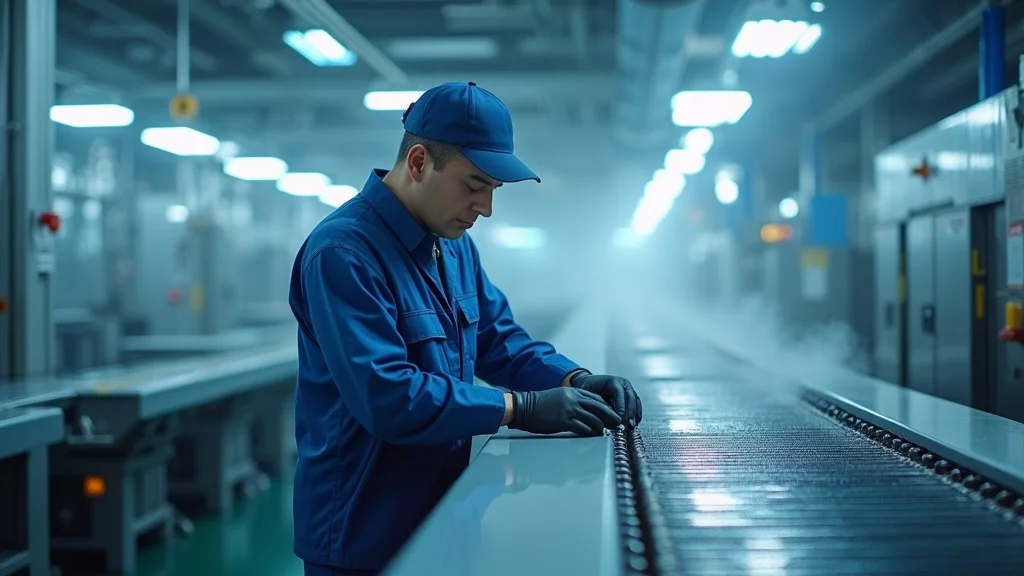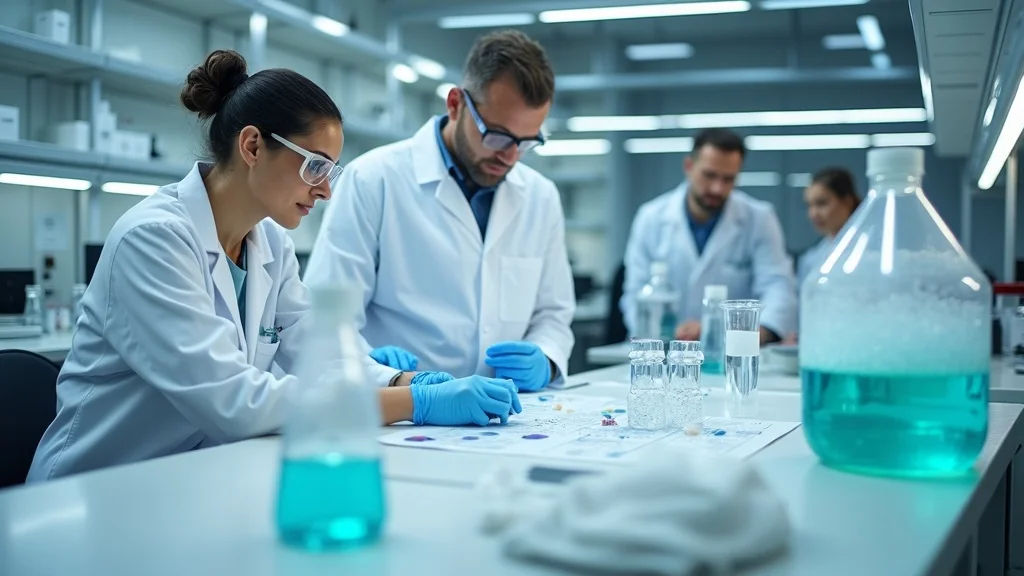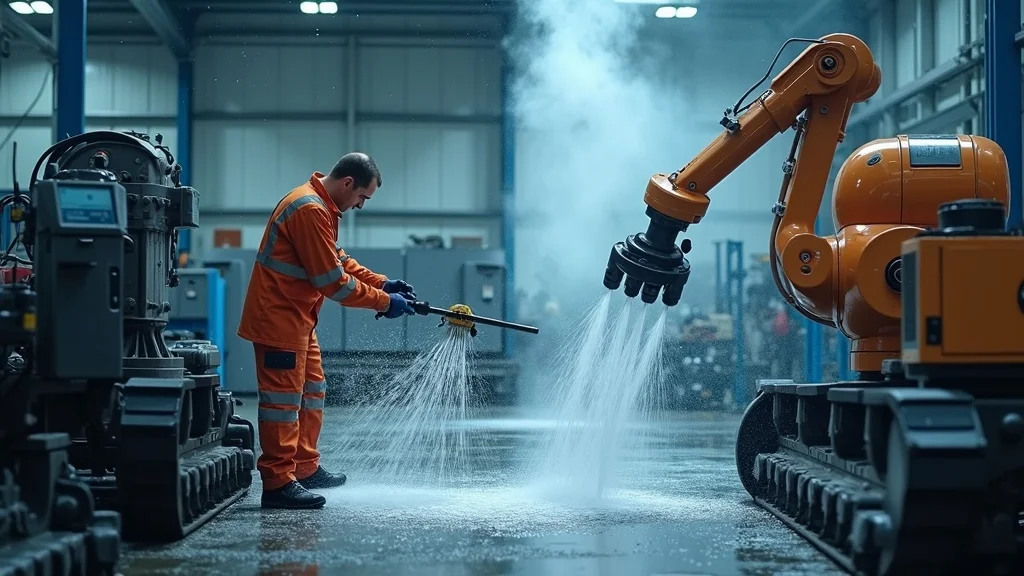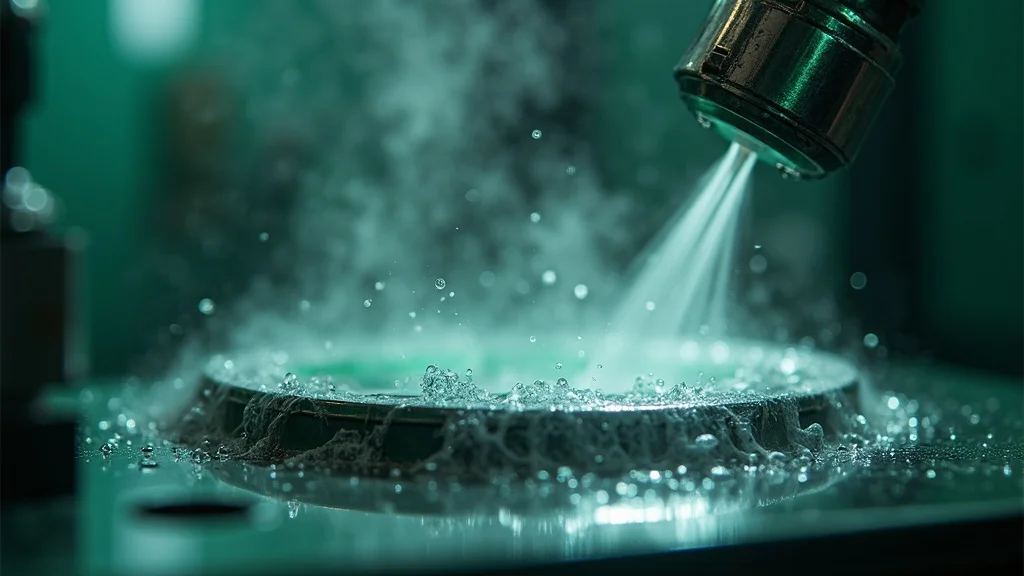Did you know that over 70% of product failures in manufacturing can be traced back to inadequate cleaning? That’s a staggering figure—one that places the principles of industrial cleaning in the spotlight for any business serious about quality, efficiency, and reliability. In this comprehensive guide, we’ll break down the science, the methods, and the decision-making behind getting surfaces perfectly clean—so your manufacturing outcomes aren’t left to chance.
Startling Facts: Why the Principles of Industrial Cleaning Are Critical for Industry Success
Flawless industrial cleaning is more than just a box to check during production—it is a core driver of manufacturing quality. From coatings to adhesives, nearly every step that adds value relies on a surface that’s been treated according to the principles of industrial cleaning. Inadequate cleaning can cause coatings to fail, lead to unexpected corrosion, or compromise process efficiency throughout an entire industrial facility. Additionally, regular cleaning practices tailored to the right cleaning process maintain a safe work environment and protect both products and people from hazardous materials. By mastering these principles, companies dramatically reduce costly rework, extend equipment life, and reduce environmental impact, ultimately setting the standard for competitive success.
The Industrial Cleaning Industry by the Numbers
Industrial cleaning is a global industry valued in the billions, employing hundreds of thousands and serving every type of manufacturing plant, from aerospace to electronics. Well-designed cleaning services significantly lower maintenance costs and reduce the frequency of downtime while also ensuring compliance with increasingly strict environmental and health and safety standards. The use of the right cleaning agent and cleaning equipment, guided by modern principles of industrial cleaning, leads to increased productivity, fewer operational failures, and a marked improvement in workplace morale.
“Over 70% of product failures in manufacturing are traced back to inadequate cleaning—highlighting the need for mastering the principles of industrial cleaning.”
What You’ll Learn About the Principles of Industrial Cleaning
-
-
Definitive understanding of the core principles of industrial cleaning
-
-
-
How to choose the right cleaning agent and cleaning equipment
-
-
-
The science behind professional industrial cleaning service methods
-
-
-
Selection, performance, and compliance with safety and environmental standards in industrial cleaning
-
-
-
Answers to key People Also Ask questions about cleaning principles and housekeeping
-
Introduction to the Principles of Industrial Cleaning
At its heart, industrial cleaning involves the removal of dirt, oil, contaminants, and debris from machinery, equipment, substrates, or workspaces within an industrial setting. Why is this so important? Because a perfectly clean surface forms the bedrock of high-quality coatings, welds, plating, painting, and corrosion protection. If contaminants are left behind, they can cause coating failures, accelerate corrosion, or undermine the long-term durability of a product. Understanding the principles of industrial cleaning means you can choose the right cleaning service or cleaning agent for every application—making the difference between costly downtime and streamlined, efficient work processes. From manual techniques to advanced automated cleaning equipment, the fundamentals remain: the cleaner the surface, the better the outcome.

Defining Industrial Cleaning, Industrial Cleaning Service, and Professional Industrial Cleaning
Industrial cleaning refers to specialized processes that clean machinery, components, surfaces, and spaces in manufacturing plants, warehouses, or similar environments. Unlike commercial cleaning, which focuses on offices or retail spaces, industrial cleaning tackles heavy contamination—think oil, scale, production residue, and hazardous material—while addressing safety and compliance. An industrial cleaning service combines expertise, purpose-built cleaning equipment, and vigilant safety practices, often including treatments that prepare surfaces for painting or further processing. Professional industrial cleaning is the gold standard, using science-based cleaning agents, advanced techniques, and strict standards to ensure predictable, high-quality results—vital for sectors with no room for error, such as aerospace, automotive, or food manufacturing.
Why Surface Perfection Matters: The Role of Industrial Cleaning in Industry
The integrity and longevity of finished products often depend on the meticulous removal of all contaminants before further treatment. Proper application of the principles of industrial cleaning guarantees surfaces are free from oils, rust, carbon smut, and other residues that interfere with adhesion, coating, or assembly. Not only does this ensure product durability and safety, but it also measurably reduces waste, rework, and environmental hazards. Thus, regular cleaning—guided by proven principles and leveraging professional industrial cleaning service methods—boosts operational efficiency, reinforces safety standards, and upholds a strong reputation for quality in every industrial facility.
For those interested in how these principles translate into real-world solutions, exploring the range of specialized cleaning products and equipment available can provide practical insights into selecting the right tools for every industrial cleaning challenge.
The Core Questions: Foundations of the Principles of Industrial Cleaning
What Is Industrial Cleaning and Why Is It Crucial to Cleaning Service?
Industrial cleaning is a systematic approach to removing contamination from surfaces, machinery, and facilities to ensure optimal function, prevent damage, and maintain compliance with regulatory and health and safety benchmarks. It is a critical phase before processes like coating, painting, or assembling, directly affecting product quality and durability. The right cleaning service leverages the principles of industrial cleaning, selecting cleaning agents and processes adapted to both the nature of the contaminant and the substrate. Whether the goal is to prepare surfaces for advanced coatings or simply to maintain a clean and safe work environment, industrial cleaning is always more than skin-deep, ensuring both visible and invisible contaminants are addressed.
When and How Are Principles of Industrial Cleaning Applied in Operations?

The principles of industrial cleaning are woven into nearly every production stage—from initial machining and forming to final assembly and finishing. Cleaning typically occurs before painting, plating, or welding, but may also be required between production steps to remove hazardous materials or prevent cross-contamination. Facilities may employ a detailed cleaning schedule, often supported by both manual and automated cleaning services, to ensure every surface meets stringent standards. Choosing the correct cleaning agent, equipment, and technique is crucial—whether through pressure washing, ultrasonic baths, or vapor degreasing—and should be based on the unique combination of soil, substrate, and desired outcome. Consistent application of these principles ensures predictable, repeatable results and minimizes risk for process failures.
How Clean Is Clean Enough? Measuring Success in Industrial Cleaning
Cleanliness standards depend on the intended application. For instance, a machined part may only require the removal of gross oils, while a surface destined for high-end painting needs to be spotless, often verified through “white glove” testing, water-break tests, or microscopic analysis. The cleaning process is only successful when cleanliness is quantified and confirmed. Advanced facilities utilize laboratory tests, surface tension measurements, or adhesion tests to verify the efficacy of each cleaning step—ensuring every cleaned part meets or exceeds its specifications. Regular quality control not only increases product reliability but also demonstrates compliance with demanding safety and environmental standards vital in a modern industrial setting.
Tools to Measure Cleanliness: Cleaning Equipment and Advanced Testing
A wide range of tools is available to assess the effectiveness of an industrial cleaning service. Visual inspections, wipe tests, and water-break tests are simple but effective frontline methods, while specialized cleaning equipment can incorporate real-time microbial counters or surface energy meters. Automated sensors, digital record-keeping, and traceability systems in professional industrial cleaning setups ensure that stringent specifications are met consistently. This use of advanced technology empowers facilities to meet the dual demands of efficiency and regulatory compliance, cementing the role of measurement as a central pillar of the principles of industrial cleaning.
Key Variables in Choosing Industrial Cleaning Agents and Cleaning Equipment
Soil and Substrate: Matching Cleaning Agent to Contaminant
Every cleaning challenge begins with the right match between the soil (contaminant) and the substrate (surface being cleaned). Common soils include oil, rust, carbon, scale, lubricants, or hazardous material, while substrates might range from steel or aluminum to specialty alloys or plastics. The wrong cleaning agent could damage sensitive components or leave residues that compromise further processing. Alkaline cleaners cut through oils, acid cleaners tackle rust, and solvent-based cleaners excel at dissolving persistent greases. Effective industrial cleaning systematically assesses these variables before recommending a cleaning product—frequently combining multiple agents and techniques to suit a facility’s unique needs.
Part Size, Configuration, and Selecting the Right Cleaning Service
The size and shape of parts being cleaned also dictate the correct industrial cleaning service or equipment. Small, intricate parts benefit from immersion or ultrasonic cleaning, where all surfaces are wetted and agitated, while large assemblies may require spray washing or manual techniques to address complex geometries and difficult-to-reach areas. Professional industrial cleaning service providers analyze each part’s construction to minimize risk to fragile edges or critical surfaces. Choosing the right method ensures complete removal of contaminants and optimizes productivity, especially in high-throughput operations such as those in automotive or electronic manufacturing plants.

Balancing Cost, Safety, and Environmental Impact in Industrial Cleaning Service
Performance is never solely about cleanliness—cost, operator safety, and environmental impact must be weighed carefully. Stronger cleaning agents may work fast but could pose health and safety hazards or complicate waste disposal. Modern industrial cleaning solutions often aim for a balance: selecting agents and equipment that deliver results without undue risk or environmental burden. For instance, biodegradable cleaning agents are gaining traction due to restrictive chemical emissions laws and growing corporate environmental responsibility. Proper PPE, ventilation, and disposal methods are all part of this balancing act—ensuring efficient work without compromising long-term safety or sustainability.
The Four Key Principles of Industrial Cleaning: Time, Temperature, Concentration, and Force
-
-
Time: Importance of contact duration
-
-
-
Temperture: Role in cleaning reaction speed
-
-
-
Concentration: How too much cleaning agent can hurt
-
-
-
Pressure/Force: Mechanical agitation via cleaning equipment or pressure washing
-
The cleaning process relies on a delicate balance of four primary factors: time, temperature, concentration, and force. These principles of industrial cleaning interact to maximize contaminant removal and reduce risk to sensitive substrates.
Time allows cleaning agents to penetrate and react with soils; insufficient exposure may leave residues behind. Temperature accelerates chemical reactions—raising temperatures often improves cleaning speed but can increase costs and pose safety concerns.Concentration refers to the amount of cleaning agent used; while more chemical may seem better, high concentrations can damage parts or complicate rinsing. Pressure or force, delivered by agitation or pressure washing, physically assists in soil removal, especially in automated cleaning systems. Understanding these factors enables professional industrial cleaning service providers to optimize each cleaning cycle based on the unique needs of the job.
See how time, temperature, concentration, and pressure interact for perfect cleaning results in this short animation. Observe grime removal, heated tanks in action, and the effects of mechanical force versus gentle soaking—all drawn from real-world industrial environments.
Common Methods Used in Professional Industrial Cleaning Services
Manual Cleaning Versus Automated Cleaning Services
Manual cleaning in industrial settings still plays a crucial role when parts are delicate, unique, or located in hard-to-reach spaces. This hands-on process uses scrubbing, hand wands, or wipes and is best for customized jobs but can be labor-intensive, inconsistent, and potentially expose workers to hazardous materials. On the other hand, automated cleaning services—ranging from conveyorized spray washers to robotic systems—offer precision, repeatability, and speed. Automated cleaning equipment can be programmed for specific cycles, ensuring thorough surface preparation while lowering labor costs and minimizing health risks to personnel. Deciding between manual and automated approaches depends on the complexity of the cleaned items, the production volume, and safety requirements, with many industrial cleaning services employing both for maximum flexibility.

Vapor Degreasing, Immersion, and Spray Washer Systems
Each industrial cleaning method serves a different need. Vapor degreasing, though less common due to chemical regulations, uses solvent vapors to remove greases from complex assemblies. Immersion cleaning bathes parts in cleaning agents—ideal for bulk or intricate items. Spray washer systems, a mainstay of professional industrial cleaning service providers, use heated and pressurized cleaning solutions to ensure top-tier cleaning for metal stamping, automotive, and electronics. These systems are often multi-stage, incorporating rinsing and drying cycles for turnkey, consistent results, and are preferred when high production throughput and uniformity are required.

Ultrasonic, Pressure Washing, and Vibratory Cleaning Equipment
Ultrasonic cleaning harnesses the power of high-frequency sound waves to release contaminants from tight crevices, making it a preferred method in electronics and precision manufacturing. Pressure washing employs jets of water, often heated and combined with detergents, to strip away stubborn soils and residues—perfect for large machinery or facility surfaces. Vibratory cleaning equipment uses abrasive media in oscillating tubs—simultaneously cleaning, deburring, and finishing small components en masse. By selecting from these advanced cleaning processes and equipment, industrial cleaning services ensure even the toughest contaminants are removed without damaging valuable substrates or endangering personnel.
Surface Preparation and the Principles of Industrial Cleaning in Metal Finishing
Metal Processing and Cleaning Agents for Pre-treatment
Surface preparation is the linchpin of reliable metal finishing. Whether starting with hot or cold-rolled steel, annealed parts, or components recently oiled for corrosion protection, the first order of business is a rigorous cleaning process. Different metal processing steps introduce unique soils—ranging from drawing compounds, coolant residues, to scale. Selecting the right pretreatment, be it alkaline degreasing, pickling, or proprietary surfactant blends, ensures that subsequent coatings, plating, or painting are free to bond directly to the metal substrate, achieving high-performance and longevity.
Welding Residues, Phosphatizing, and the Industrial Cleaning Service Process
Industrial cleaning services often contend with residues from welding or forming—including flux, soot, and oily smut—which are notorious for causing adhesion defects in subsequent coatings. Phosphatizing is an essential conversion coating process: iron phosphate creates an ideal base layer for paint, while zinc phosphate dramatically improves corrosion resistance. Each step must be meticulously cleaned and rinsed, and sometimes sealed, to ensure the surface is chemically and physically prepared for downstream processes. Failure to follow these established principles of industrial cleaning can lead to poor cosmetic finish and costly failures in service.
The Importance of Rust Preventatives and Proper Sealing
Even after thorough cleaning and coating, metals remain vulnerable to rust during storage or shipment. The use of rust preventatives—whether oil-, wax-, or amine-based—offers an additional barrier. Sealing rinses further protect parts during handling and transitional storage. Attentive application of these finishing touches ensures that the investment in professional industrial cleaning service pays off, with surfaces remaining pristine right up to assembly or final shipment.
Quality Control in Industrial Cleaning: Testing and Assurance
Paint Booths, Airflow Management, and Cure Control
Industrial cleaning doesn’t end when the visible dirt is gone. In paint finishing processes, for example, managing airflow to remove overspray and maintaining consistent temperatures for proper curing are both essential. Airflow design prevents dust and contaminants from re-settling on cleaned parts, while oven and cure controls ensure that the freshly applied coatings adhere and set exactly as needed. These environmental and process controls, hallmarks of quality-focused industrial cleaning service providers, safeguard the value added by earlier meticulous cleaning.
Testing Coating Quality: Cross-Hatch, Salt Spray, and Performance Review
Testing is the final line of defense against costly failures. Cross-hatch adhesion tests determine whether paints or coatings will withstand handling and service. Salt spray and humidity chambers are harsh simulation environments that test corrosion resistance under accelerated conditions. Additional performance reviews check for blistering, creepage, or pinhole rusting—clear evidence of missed contaminants or weaknesses in the cleaning process. With these methods as standard, professional correct or appropriate cleaners help businesses avoid rework and strengthen reputations for reliability and performance.
Deep Dive: Industrial Cleaning Agents and How They Work
-
-
Alkaline Cleaners for oils and greases
-
-
-
Neutral Cleaners for light soils in commercial cleaning
-
-
-
Acid Cleaners for heavy rust and scale
-
-
-
Solvents and Emulsion for persistent contamination
-
Every effective cleaning process is anchored in choosing the correct cleaning agent or chemical, each tailored to a specific application. Alkaline cleaners are staples in industrial cleaning, quickly dissolving stubborn oils and greases found in most manufacturing plants. Neutral cleaners, less aggressive, are paired with light soils or used where sensitive surfaces or coatings demand minimal reactivity. Acid cleaners excel at removing rust, scale, or welding smut—and require careful handling due to their strength and potential harm to certain metals. Solvents and emulsion cleaners are mainstays for heavy, oily contamination or when parts cannot be easily rinsed. Professional industrial cleaning service providers select their cleaning agents only after considering all variables—soil type, safety standards, environmental impact, and the substrate’s chemistry.
Chemical Cleaning versus Mechanical Cleaning Agents
Chemical cleaning involves the use of detergents, acids, alkalis, and solvents that chemically react with contaminants, dissolving or emulsifying them for easy removal. Mechanical cleaning relies on physical forces—scrubbing, brushing, pressure washing, or blasting—to dislodge contaminants. Often, the most robust industrial cleaning services are those that combine both: using chemical cleaners to loosen soils and mechanical agitation to ensure even the tiniest crevices are spotless. This combination delivers unparalleled cleaning power, safely and efficiently, within modern manufacturing facilities.
Key Ingredients in Modern Industrial Cleaning: Surfactants, Chelants, and More
-
-
Surfactants and Soap Types (anionic, cationic, nonionic, amphoteric)
-
-
-
Alkalis and Chelants
-
-
-
Acids and Solvents
-
Today’s industrial cleaning solutions are advanced blends containing surfactants—special molecules that reduce the surface tension of water, helping it penetrate and lift away grime. Different surfactant types, such as anionic, cationic, nonionic, or amphoteric detergents, serve unique purposes depending on the soils and substrates involved. Alkalis (like sodium hydroxide), chelating agents (EDTA, sodium gluconate), acids, and a variety of solvents are matched in precise proportions to balance cleaning power against safety and environmental impact. Professional industrial cleaning services are increasingly turning to safer, greener formulations that protect both workers and the world around us.
“The future of industrial cleaning services relies on innovation in eco-friendly detergents and safer chemical agents.” – Industry Expert
Glossary Snapshot: Terms Every Industrial Cleaning Professional Must Know
-
-
Phosphatizing
-
-
-
Passivation
-
-
-
Saponification
-
-
-
Water-Break Test
-
-
-
Conversion Coating
-
People Also Ask: Principles of Industrial Cleaning
What are the 5 principles of cleaning?
Answer: The 5 principles of cleaning are time, temperature, mechanical action, chemical action, and the nature of the contaminant. In industrial cleaning, balancing these ensures optimal results.
What are the 7 principles of housekeeping?
Answer: The 7 principles of housekeeping include sorting, setting in order, shining, standardizing, sustaining, safety, and discipline, all of which are foundational to effective cleaning services and industrial cleaning processes.
What are the 4 principles of cleaning?
Answer: The 4 main principles of cleaning are chemical concentration, mechanical action, temperature, and time. These are central to professional industrial cleaning service practices.
What are the 7 steps in the cleaning process?
Answer: The 7 steps in the cleaning process are: preparation, pre-cleaning, main cleaning, rinsing, disinfection, final rinse, and drying. Strict adherence to these is key to successful industrial cleaning.
Frequently Asked Questions about the Principles of Industrial Cleaning
-
-
What is the difference between industrial cleaning and commercial cleaning?
Industrial cleaning targets heavy-duty contaminants in manufacturing environments, using specialized cleaning agents and equipment, whereas commercial cleaning covers light-duty environments such as offices or retail, typically involving less hazardous material and simpler cleaning processes.
-
-
-
How do professional industrial cleaning services ensure safety standards?
They comply with rigorous health and safety regulations, select appropriate cleaning agents, train staff in the safe use of cleaning equipment, and employ strict procedures for hazardous material handling and waste disposal.
-
-
-
Which cleaning agents are most environmentally friendly for industrial applications?
Biodegradable, non-toxic cleaners, and surfactant-based solutions with low volatile organic compounds (VOCs) offer effective cleaning with minimal environmental impact, making them popular choices for sustainable industrial cleaning services.
-
Key Takeaways: Principles of Industrial Cleaning
-
-
Understanding and applying the principles of industrial cleaning leads to longer equipment life, fewer process failures, and better product quality.
-
-
-
Effective cleaning service hinges on correct agent, equipment, and process selection for the substrate and contaminant.
-
-
-
Compliance with environmental and safety regulations is non-negotiable for professional industrial cleaning services.
-
Conclusion: Master the Principles of Industrial Cleaning for Reliable Manufacturing Outcomes
Make industrial cleaning a science-backed priority for consistent quality and operational excellence. Call Lisa at (262) 891-2314 or visit Industrial & Locomotive Cleaning Solutions to tell Lisa what you want and get her expert recommendations for your facility’s success!
If you’re eager to deepen your understanding of the people and expertise behind these industrial cleaning solutions, take a moment to discover more about the team and their approach. Learning about the company’s values and commitment to innovation can help you make more informed decisions as you implement advanced cleaning strategies. By connecting with industry leaders who prioritize both performance and sustainability, you’ll be better equipped to elevate your facility’s standards and stay ahead in a competitive landscape. Explore their story and see how their experience can inspire your next steps in industrial cleaning excellence.
